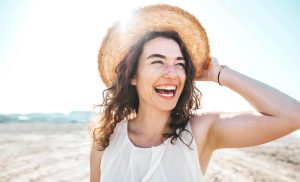Say Goodbye to Tooth Decay With Ceramic Dental Fillings
Are you looking for a lasting dental restoration compatible with your body? With ceramic fillings, dentists can repair damaged or decayed teeth, offering several key advantages over traditional amalgam or composite fillings, including aesthetic appeal, durability, and biocompatibility. At Gulf Gate Dental, we may not offer ceramic dental fillings, but you can schedule an appointment at Gulf Gate Dental with one of our Sarasota, FL, dentists to explore your dental filling options. Call our Southwest Florida dental practice at (941) 921-2122 to learn more.
What Are Ceramic Fillings?
Ceramic fillings, also known as ceramic inlays or onlays, are dental restorations used to repair teeth damaged by decay or trauma. These dental fillings are made from biocompatible ceramic materials and are customized to match the natural color and shape of your teeth.
Ceramic fillings are often recommended for:
- Small to moderate-sized cavities
- Patients seeking a more natural appearance
- Those with metal allergies or sensitivities
Types of Ceramic Materials
Ceramics are a diverse class of materials known for their high strength, heat resistance, and chemical stability. They are widely used in various applications, from everyday items like dishes to high-tech components in spaceships. Here’s a closer look at two common types of dental ceramics:
Porcelain
Porcelain is a type of ceramic made from a mixture of kaolin clay, feldspar, and quartz. Porcelain can withstand strong biting forces, making it suitable for fillings in areas that experience a lot of wear.
Porcelain can also be closely matched to the natural color of teeth, providing a natural-looking restoration. Porcelain is a popular choice for dental fillings, crowns, and veneers. However, it may not be as durable as some other materials, such as zirconia.
Zirconia
Zirconia is a ceramic material made from zirconium oxide (ZrO2). It’s strong and resistant to chipping and cracking, making it ideal for long-lasting restorations. Zirconia is well-tolerated by the body, making it a good choice for people with allergies or sensitivities to other materials.
Due to its superior strength, zirconia is often used for dental crowns, bridges, and implants. While not quite as translucent as porcelain, zirconia can still achieve a natural-looking appearance.
Benefits of Ceramic Fillings
Ceramic fillings offer several advantages over traditional fillings, making them popular for many patients. Here’s a detailed breakdown of their key benefits:
- Aesthetic Appeal: Unlike traditional metal fillings, ceramic fillings are tooth-colored, allowing them to blend seamlessly with surrounding teeth. This creates a natural and aesthetically pleasing look, especially when placed in visible areas like front teeth.
- Durability: Ceramic fillings are highly resistant to wear and tear. They can withstand strong biting forces and are less likely to chip or fracture than other filling materials. This translates to longer-lasting restorations and potentially fewer dental visits in the long run.
- Biocompatibility: Ceramic is a biocompatible material, meaning it’s well-tolerated by the body and less likely to cause allergic reactions. This is especially important for patients with sensitivities to metals used in traditional amalgam fillings.
- Minimally Invasive Procedure: Compared to traditional fillings, placing ceramic fillings often requires removing less healthy tooth structure. This helps preserve the natural integrity of the tooth and minimizes potential discomfort during the procedure.
- Stain Resistance: Ceramic fillings are generally more resistant to staining from coffee, tea, or other beverages than other filling materials. This helps maintain a brighter and more natural-looking smile.
- Improved Tooth Strength: In some cases, ceramic fillings can strengthen the weakened tooth structure, providing additional support and protection.
The Ceramic Filling Procedure
- Diagnosis and Treatment Planning: Your Sarasota dentist will assess the extent of tooth damage and discuss treatment options, including ceramic fillings.
- Tooth Preparation: The damaged tooth is prepared by removing decayed and weakened areas while preserving healthy tooth structure.
- Impression and Temporary Filling: An impression is taken to create a customized ceramic filling. A temporary filling may be placed to protect the tooth while the permanent restoration is created.
- Custom Fabrication: The ceramic filling is fabricated in a dental laboratory to precise specifications, including color and shape.
- Bonding and Cementation: Once the custom filling is ready, patients will return for their next appointment. The custom ceramic filling is then bonded to the prepared tooth using dental cement, ensuring a secure fit and beautiful look.
Ceramic Fillings vs. Other Filling Materials
Ceramic Fillings vs Silver Amalgam Fillings
- Aesthetics: Ceramic fillings are tooth-colored and blend in seamlessly with natural tooth structure for an excellent cosmetic result. Silver amalgam fillings are made from a mixture of metals like silver, tin, copper, and mercury which gives them a dark, metallic appearance that contrasts sharply with tooth enamel.
- Durability: Ceramic fillings are extremely durable and resistant to fracturing or wearing down. With proper care, they can last 10 to 20 years. Amalgam fillings are also very durable, but can eventually start breaking down at the edges, allowing bacteria to seep underneath and cause further decay. Also, ceramic does not expand and contract with temperature changes like metal amalgam, providing a tighter seal.
- Biocompatibility: Ceramic is a naturally occurring, non-toxic substance that integrates well with the body’s tissues. Amalgam contains mercury, which has raised concerns over potential toxicity, though the amounts used are considered safe by regulatory bodies.
Ceramic vs Composite Resin Fillings
- Aesthetics: Both ceramic and composite resin fillings can be made in natural tooth shades for an inconspicuous appearance. Also ceramic may be slightly more stain-resistant than some composites over time.
- Durability: Ceramic materials like porcelain and zirconia are significantly harder and more durable than composite resins. Composites, though strong, can be more prone to chipping, cracking, or wearing down over a five to ten-year period.
- Tooth Preparation: Composites can often be “painted” onto the tooth with minimal removal of existing tooth structure. Ceramic fillings or inlays require more of the tooth to be reshaped and prepped to accommodate the rigid ceramic material.
Frequently Asked Questions
Ceramic fillings are highly stain-resistant, but it’s advisable to avoid excessive consumption of stain-causing substances like coffee and red wine.
Yes, ceramic fillings are an excellent choice for front teeth due to their natural appearance.
On average, ceramic porcelain fillings last about 10 to 15 years, but some can last much longer with proper care and regular dental visits.
Learn More About Ceramic Fillings, Contact Our Sarasota Dental Team Today!
Ready to get your oral health back on track? At Gulf Gate Dental, our Sarasota, FL, dentists offer dental fillings to ensure you can stop cavities in their tracks. Contact our Sarasota dental office today by calling (941) 921-2122 for an appointment. Gulf Gate Dental welcomes patients from South Sarasota, Beneva, Gulf Gate Estates, Vamo, Siesta Key, Osprey, Bee Ridge, and the surrounding areas of Sarasota, FL.







